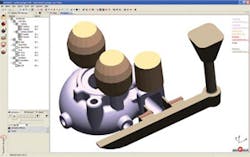MAGMA5 Coordinates Process Information, Perspectives to Reveal the Entire Production Process for Parts
The latest release in casting process simulation software is MAGMA5 from MAGMA GmbH. Over the more than 20 years that the company has developed its MAGMASOFT® casting process simulation program, its axiom has been, “First understand, then optimize.” MAGMA5 follows this standard by delivering a thorough understanding of casting processes, thereby making it possible to optimize the entire production process for cast parts. Specifically, MAGMA5 software achieves this by allowing users different and simultaneous views and perspectives of the component.
Simulation software is used by metallurgists, designers, and process engineers to simulate a metalcasting process before starting series production. It is particularly valuable for establishing an accurate description of a finished casting’s quality, but it is also used to optimize casting methods that will achieve the properties required for the final component. Because this reduces pre-production sampling it avoids the need to define a complete casting route prior to series production, resulting in energy, material, and tooling savings.
MAGMASOFT® programs address all cast alloys (cast iron, aluminum, steel) and processes, including sand casting, permanent mold casting, and diecasting, including large steel castings. The software allows users to model the final component, determine the melting practice and casting method, and test the different effects of mold making, heat treatment, and finishing.
Using MAGMA5, casting designers and engineers can specify and carry out each stage of a process simulation — geometry input; design of gating, risering and tooling; solidification; and finishing processes, like heat treatment. In these “process perspectives,” all information about the selected materials, metallurgy and melting practice, production conditions and finishing processes (e.g., heat treatment) are coordinated together, so that the user has a complete overview of the entire manufacturing process being simulated.
This process orientation forms the basis of more profitable and effective casting operations, according to MAGMA, specifically with improved casting layouts, higher standards of quality, and cost savings.
MAGMA5 also provides important new casting process simulation capabilities. For gravity casting, new advanced turbulence models and the consideration of surface tension improve mold-filling predictions. Also, tracer particles can be modeled with mass and size to evaluate slag inclusions, and burn-on and penetration criteria help to identify sand-related surface defects.
There are also new modules available with MAGMA5.
MAGMAnonferrous simulates as-cast local microstructures and properties of aluminum alloys. A new and comprehensive plasticity model provides improved accuracy, because it considers temperature-dependent as well as time-dependent effects on stresses and strains. And, the thoroughly redeveloped stress module,
MAGMAstress, offers users the option of simulating thermally induced casting stresses for the entire manufacturing route.
In MAGMA5, simulation results like 3D graphics, diagrams, and tables can be displayed in multiple views and in selectable levels of detail, so the results can be evaluated with confidence.
The new methodology is reflected in the software’s architecture. Technically, MAGMA5 is built on an entirely new platform that has long-term value because it can be extended or scaled on a modular basis. Due to standard interfaces that allow free import and export of data, MAGMA5 can be completely integrated into the user’s work environment.
Using MAGMA5 with new hardware and operating systems presents new opportunities. It is a native Windows-compliant program that runs on 64-bit Windows operating systems, taking advantage of greatly increased memory access. For Linux users, MAGMA5 is available for the current SUSE processing standard. According to MAGMA, the combination of MAGMA5 and the latest hardware (Core i7/Neharlem CPU) will reduce simulation times by up to a factor of five.
MAGMA5 Version 5.0 supports all major sand casting processes, and MAGMA5 Version 5.1 is available to simulate permanent mold casting and diecasting, including gravity diecasting.
